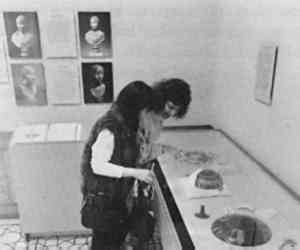CAN THE COMPLEX BE MADE SIMPLE? INFORMING THE PUBLIC ABOUT CONSERVATION THROUGH MUSEUM EXHIBITSJERRY C. PODANY, & SUSAN LANSING MAISH
4 TREATMENTThe section on treatment began with an interactive activity that involved two fragmentary reproduction vases. Visitors were invited to join broken pottery fragments and then identify the name of the vase from a chart of Greek vase shapes. We hoped this activity would give visitors an idea of the patience and manual dexterity that conservators need, but, more important, we wanted to help them make connections among all aspects of the exhibit. This activity could be criticized for encouraging a common public perception of conservation as an activity involving putting together old pots, but it proved to be an effective method of getting visitors interested in the subject matter of the exhibition. The vase exercise effectively introduced a display on ceramic conservation that described the step-by-step procedures a conservator may employ to complete the shape of a fragmentary vessel. The steps involved in the reconstruction of a Greek kylix cup were laid out in a horizontal case (fig. 2).
The treatment of ancient bronze and marble objects was illustrated by before-and-after color photographs of two portrait busts from the collection. Wall-mounted text panels amplified the philosophy behind the treatment as well as the treatment process itself. Further explanations and photographic documentation of mechanical cleaning techniques were located in the notebook on the podium below the wall display (fig. 2). Too often, people learn about conservation from the presentation of stunning, dramatic before-and-after views. This technique is an assured way to attract attention but an ineffective method of keeping it. The comparison of the conservator-object relationship to the doctor-patient relationship has tinged the profession with an often unrealistic, and certainly overly romantic, tone. The surgeon making a dramatic decision to operate, resulting in the patient's miraculous recovery, makes a better character in a novel than does the practitioner who advises on good diet and exercise. Yet in reality, and especially in our modern world, prevention is preferred over intervention, both in medicine and in art. In our exhibition, we tried to minimize the strong but overemphasized doctor-conservator analogy and raise other concerns more pertinent to modern preservation. |
